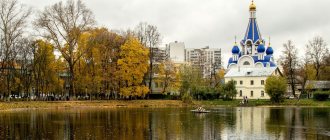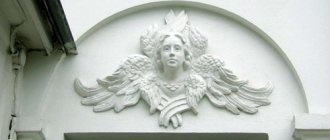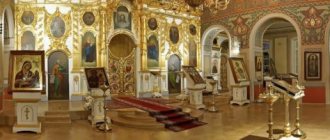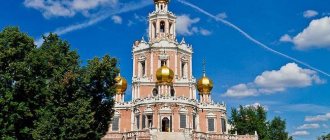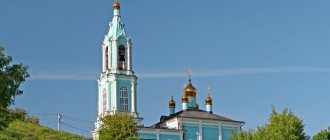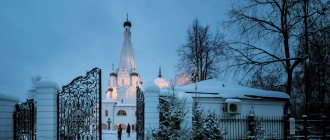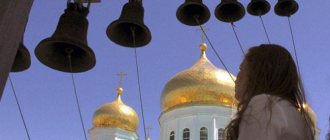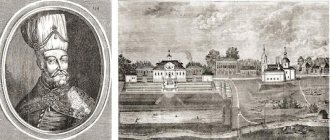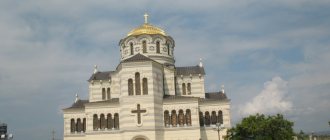In the Moscow region, not far from Podolsk, at the place where the two rivers Desna and Pakhra merge, there is the Dubrovitsy estate, which once belonged to the princely Golitsyn family. The estate ensemble includes the currently operating unusual Church of the Sign of the Blessed Virgin Mary, built and consecrated in 1704.
Website
(Website of the Trinity Deanery of Moscow and the Church of the Icon of the Mother of God “Unexpected Joy” in Maryina Roshcha)
Go to the menu (see the “Central Temple” section on the main page on the right).
The temple is called central, since its rector is the dean of the churches of the Trinity District, Archpriest Georgy Klimov.
Postal address: 127521, Moscow, st. Sheremetyevskaya, 33.
Art. metro: Maryina Roshcha, VDNH, Rizhskaya, Belorusskaya, Tsvetnoy Boulevard.
Telephone.
View the schedule of services
Architecture
The church is surrounded by a porch with an open view. The foundation of the Church of the Sign is made in the shape of a cross of regular geometric shape. Each end of the cross falls into three parts with rounded outlines, decorated with small columns stylized as Corinthian capitals. The foundation of the church is a stone bas-relief decorated with carvings. Wide staircases located on different sides lead to doorways into the temple. The doors and windows are decorated with processed large stones. On the sides there are decorative columns supporting the frieze carvings.
The central entrance to the building is marked by two stone statues. On the right hand is a sculpture of John Chrysostom, to the left of the entrance is a stone statue of Gregory the Theologian. On the roof on the western side, directly above the entrance, rises the stone silhouette of Basil the Great, the theologian. In the rounded depressions there are four figures of the apostle-evangelists. The corners of each of the 8 faces are decorated with apostolic statues.
Instead of a traditional dome, the church is crowned with a royal crown, as if resting on dormer windows decorated with plant motifs. This rare architectural detail is unusual for Orthodox churches.
Directions
By public transport:
- m. "Maryina Roshcha" - bus. 19, 24, 126, 12, T15; troll 13 to the stop “Polyclinic” or “Sheremetyevskaya Street”.
- m. "Belorusskaya" - bus. 12;
- m. "Rizhskaya" - bus. 19;
- m. "VDNKh" - troll. 13, 69;
- m. "Tsvetnoy Boulevard" - troll. 13, auto. 24.
By car
- From the outside of the Third Transport Ring, turn onto Sheremetyevskaya Street, then turn under the Ostankino overpass towards the center.
- From the inside of the Third Transport Ring, turn to the right before the Suschevsky Tunnel and turn onto Sheremetyevskaya Street.
- From Academician Koroleva Street, turn onto Novomoskovskaya Street, which turns into Sheremetyevskaya Street.
Construction
Until 1690, there was an Ilyinskaya wooden church on the territory of the estate. In 1690, on July 22, after the disgrace of Prince Golitsyn, in memory of forgiveness by Emperor Peter the Great, the owner founded a stone church in honor of the icon of Our Lady of the Sign. Construction lasted 13 years.
The author of the project is unknown, but there are several versions about the school of the designer. According to one, it was Italian; according to another, the style of the building resembles South German architecture. On February 11, 1704, the temple was consecrated by Stephen, Metropolitan of Ryazan and Murom. Emperor Peter himself was present at the solemn service. According to legend, it was located on the second tier of openwork choirs, where the ruler could communicate with God without interference.
Story
The temple was built in 1899–1904. at the expense of the residents of Maryina Roshcha on land donated by Count A.D. Sheremetev. Didn't close.
Architectural style: the architecture is designed in the style of ancient Russian churches of the 17th century.
Rector: Archpriest Georgy Klimov, dean of the churches of the Trinity District of Moscow
Clergyman
Archpriest Alexander Lavrukhin Priest Dionisy Mukhin Priest Dimitri Kiose Priest Nikolai Gutorov
Interior decoration
The main decor of the Church of the Sign of the Blessed Virgin Mary is biblical scenes made using the technique of high relief, for which Renaissance churches served as an example. All these floating angels, flying cherubs and large soft clouds fill the temple with air and weightlessness.
At the back of the temple there is a staircase leading to the second floor, where there are two-tiered choirs, richly decorated with light openwork carvings. The main sculpture of the temple is a large wooden Crucifix with an inscription in Latin. According to legend, the icons with the iconostasis were created by Moscow masters of the Kremlin Armory.
The Church of the Sign of the Blessed Virgin Mary is active, services have been conducted since 1990. The main shrine of the temple is the icon of the Most Holy Theotokos “The Sign”. Also in the church there is an icon of St. Tryphon, unusual in its style.
We recommend paying attention to suitable icons: Handwritten icon of the Sign 4 (Size 9*10.5 cm)
Price from: 10 500
Read more Icon of the Sign with stones
Price from: 12 500
More details Handwritten icon of the Sign
Price from: 7 000
More details
Divine service
The temple in honor of the icon of the Mother of God “Unexpected Joy” in Maryina Roshcha is open on weekdays from 7.30 to 19.00.
Divine services are held daily.
On weekdays in the morning at 8.00 and in the evening at 17.00. In the summer (from the Feast of All Saints to the Feast of the Dormition of the Blessed Virgin Mary) - only in the morning: Matins and Liturgy at 8.00.
On Sundays and holidays, two Divine Liturgies are served in the church: at 7.00 and 10.00.
The day before at 17.00 the All-Night Vigil is celebrated.
On Sundays at 5 p.m., Matins is performed with an akathist to the icon of the Mother of God “Unexpected Joy,” and on post-feast days there is an akathist to the newly arrived holiday. On Thursdays at 17.00, Matins is celebrated with an akathist to St. Nicholas the Wonderworker.
During Great Lent: daily matins, hours, fine, vespers (on statutory days with the Liturgy of the Presanctified Gifts) at 8.00 .
Moscow Church of the Vladimir Icon of the Mother of God
Church of the Vladimir Icon of the Mother of God. Moscow Sretensky Monastery. Photo: M. Rodionov / Pravoslavie.Ru
The main church in Moscow, consecrated in the name of the Vladimir Icon of the Mother of God, stood before the revolution in Kitay-Gorod, near Lubyanka Square, at the very beginning of Nikolskaya Street. It was founded by vow of Queen Natalya Naryshkina where the chapel with the Icon of Vladimir stood from ancient times. This chapel, like the church, was founded on that road and near the very place where in 1395 Muscovites greeted the miraculous image of the Mother of God from Vladimir with reverence and fear, hoping to find salvation from the terrible Timur, who was marching with an army to Moscow.
And in memory of that legendary, fateful meeting for Moscow, not only the Moscow Sretensky Monastery was founded, but also the Vladimir Chapel on the Moscow Posad, and after it the parish Vladimir Church on Nikolskaya. Its scaly head, “like a hedgehog bristling with thorns,” as a modern Moscow scholar puts it, was far visible from the surrounding area and beautifully towered over the ancient buildings of Nikolskaya Street.
The Vladimir Icon is the main Orthodox and historical shrine of Moscow, and with it the entire Russian state. According to legend, the image was painted by the Evangelist Luke himself on a board from the table at which the Savior and the Most Holy Theotokos had a meal with the righteous Joseph the Betrothed. The icon came to Rus' only at the beginning of the 14th century - then it was sent from Constantinople to Prince Mstislav, who placed it in Vyshgorod. The son of the founder of Moscow, Prince Andrei Bogolyubsky, moved it to Vladimir and installed it in the newly built Assumption Cathedral. And already in 1395, when Muscovites were awaiting the invasion of the “great lame” with horror, the icon was first brought to Moscow, where by the grace of God it remained for centuries and more than once with its miracles saved the capital city from enemies and granted victories. It was to her that the Russians tearfully prayed in the fall of 1480, when the Mongol-Tatar yoke, which had tormented Rus' for 240 years, fell - after the great stand on the Ugra River, Khan Akhmet left Moscow without a fight and forever. And in 1521, the Vladimir Icon saved Moscow from the invasion of the Crimean Khan Mengli-Girey.
It is believed that the ancient chapel with the Vladimir image was built here, on the approaches to the Kremlin, in the same 1395, when the icon was welcomed in Moscow, or later, but precisely in honor of this event, according to Moscow custom. One way or another, the chapel stood here long before the construction of the China Town wall. And when in 1534 the Italian architect Petrok Maly, the architect of the Kremlin Assumption belfry, began to build a fortress wall, then on this site it was closely adjacent to the chapel: then a tower with a gate was built here, which received the official name “Nikolsky” after the local street and “Vladimirsky " - according to the chapel. And then, around the 16th century, a copy of the Vladimir Icon was placed on the outer wall of the Nikolskaya Tower of Kitay-Gorod. This tower ended up on the section of that very epoch-making Sretenskaya road for Moscow...
And Tsarina Natalya Kirillovna Naryshkina decided to build a church here, consecrated in the name of the Vladimir Icon. Indeed, by that time, not only in Moscow, but also in this historical place there was not a single parish church in honor of the miraculous icon, but only the Sretensky Monastery and chapel. And festive religious processions from the Kremlin took place directly to the monastery. The queen made a vow to build a church here.
The reason for this was not only the significant place - the queen considered the Vladimir Icon her patroness, since her name day fell on the day of the feast of the miraculous icon. And it was in the Vladimir image that the queen’s parents (according to other sources, her teacher, boyar Matveev) blessed her on her wedding day with Tsar Alexei Mikhailovich back in 1671. It was this family image that the widowed empress donated as a royal gift to the newly built church, although she did not live to see the consecration of her votive temple.
The construction of the beautiful church in the bright, patterned style of the Naryshkin Baroque was begun by personal decree of Peter I, who loved his mother very much, in the summer of 1691 using public funds from the Streletsky Prikaz, and it was consecrated in October 1694. Then a procession of the cross was held from the Kremlin on May 21 - in celebration of the miraculous salvation of Moscow from the raid of the Crimean Khan in 1521.
What's interesting is this. Because of its location, the church was assigned to the Zaikonospassky Monastery, on Nikolskaya Street, and it was its clergy who served in this ordinary Moscow church. However, the Vladimir Church did not and could not have its own parish in the trading district of Moscow, but, as one pre-revolutionary local historian wrote, this “parishless” church had the whole of Moscow as a parish, and everyone who walked along Nikolskaya Street certainly went into the temple to pray Intercessor of the human race and Savior of Moscow.
The priceless relics of the Vladimir Church corresponded to the “palace” status of the temple, built according to the queen’s vow. She became its first donor, and after Naryshkina, both Elizaveta Petrovna and Maria Fedorovna gave rich shrouds and airs, embroidered by the hands of the empresses, to this Chinatown church. The image of the Savior Not Made by Hands, in the manner of “Fryazhsky writing”, was, according to legend, painted by Simon Ushakov himself. In the second half of the 18th century, the architect Vasily Bazhenov built a huge iconostasis in the temple. The list of the Vladimir Icon at the beginning of the 19th century was decorated with a magnificent golden chasuble with precious diamonds, pearls, emeralds and yachts - this was a gift from the famous Count N.P. Sheremetev according to his will, since the previous setting of the temple miraculous icon was “lightweight”.
And opposite the Vladimir Church on the left side of Nikolskaya there once stood the courtyard of his grandfather, an associate of Peter the Great, the first Russian Count Boris Petrovich Sheremetev. And his daughter, Natalya Borisovna, bitterly mourned here the deceased Emperor Peter II, who greatly favored her husband, Prince Dolgoruky. After the death of the young ruler, she was exiled to Siberia, and her husband was executed. Now the old way of life, when along with the Moscow suburb in the privileged Kitai-Gorod there were courtyards of wealthy boyars, only the names of the local Cherkassky lanes remind us there - the courtyard of Count Sheremetev at one time belonged to Prince Cherkassky. Later, all the aristocratic residents were forced out by trading shops, educational institutions, and business centers of Moscow's Kitay-Gorod.
In the church there was another image of the Mother of God of Vladimir, in a silver setting - the same one with which Patriarch Joachim blessed Queen Naryshkina at the wedding with Tsar Alexei Mikhailovich.
And in 1805, a new chapel appeared at the church, in which they placed a copy of the icon in a beautiful silver chasuble, built with a donation from a wealthy Muscovite. In that century, the famous “break” already existed - the new entrance gate of the Chinese city wall, broken for the sake of ease of passage to Nikolskaya Street. These breach gates were often called “Vladimirsky”.
“Prolom” had the famous collapse of the Moscow second-hand bookstores (the second largest after Sukharevka), where passionate bibliophiles, “overwhelmed by the book,” were constantly rummaging in search of rarities. One of these inhabitants of “Prolom” was the historian and head of the cadets, Professor P.N. Milyukov, who, when he was a student at Moscow University, came here every day to hold an old and valuable book in his hands - and to add to his home library.
Already in Soviet times, this tradition happily continued - as if in memory of that collapse “at Prolom”, the popular second-hand bookstore “Book Find” was built here.
But the fate of the Moscow church turned out to be sad - in the fall of 1932 it was closed and transferred to the police club. And in the summer of 1934, it was demolished along with the wall of Kitai-gorod, and exactly on the 400th anniversary of this Moscow fortress. Now on the site of the temple there is a roadway.
Kazan Cathedral on the fortress mountain and the architectural dominant of Stavropol
Kazan Cathedral
Four-tiered hundred-meter bell tower. The ground floor of the bell tower was a tomb for noble citizens. In the 30s, the cathedral was destroyed. The bell tower first became a radio mast, and then a parachute tower. Plans to turn the religious building into a monument to the heroes of the Civil War were not destined to come true. In May 1943, the city's tallest building was blown up to remove a landmark for German planes. In the 90s of the twentieth century, they decided to restore the cathedral, and Fortress Mountain was declared a protected area. After archaeological excavations, the old foundation of the temple was discovered and on Easter 2010 the first service was held in the restored Kazan Cathedral.
Russian version of the Vatican Basilica of St. Peter
Kazan Cathedral
Saint Petersburg
Paul I set this task for the architects when working on the new church in St. Petersburg. The project of the former Stroganov serf Andrei Voronikhin received approval. Construction lasted ten years, and after the victory over Napoleon’s troops, it was to the Kazan Cathedral in St. Petersburg that military trophies were brought. For the iconostasis of the Temple of Russian Military Glory, 40 pounds of silver captured on the battlefield were used. The main Orthodox shrine of the temple is a copy of the Kazan Icon that belonged to Tsarina Praskovya Fedorovna. It was this image that inspired Minin and Pozharsky during the battles with the invaders.
Temple inside the Tsaritsyn fortress with the best view of the city
Kazan Cathedral
Volgograd region
This Kazan Cathedral in Volgograd was built at the beginning of the 18th century. 120 years ago the wooden church burned down. A stone temple was built on Dar Mountain in the Old Russian style. The facades were decorated with brickwork and stucco. The architectural ensemble was completed by a parochial school for girls, a refectory and a bell tower. The cathedral did not exist in its updated form for long: the revolution deprived the temple of church values, and during the war only the walls survived the shelling. The temple was restored in the mid-twentieth century. Moscow artists came to Vladimir and painted the inside of the church. Over time, it was possible to restore the historical appearance of the cathedral - the lost hipped domes, as before the revolution.
